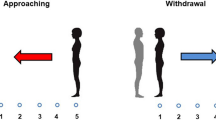Abstract
Prior research has investigated the validity of interpersonal distance measures with respect to only one trait — comfort. This study expanded the previous research by measuring interpersonal distance along the trait dimensions of comfort, control and privacy. In addition, measures were taken along three different measurement techniques: stop distance, silhouette placement, and a paper and pencil measure (CID). The results were interpreted in terms of a multitrait-multimethod matrix. Results indicated that these measures were reliable and valid and the traits did have convergent validity. However, all of these measures were uncorrelated with a disguised distance measure of interpersonal distance.
Similar content being viewed by others
Reference Note
Rawls, J. R., Trego, R. E., & McCaffey, C. N.A comparison of personal space measures (Tech. Rep. 6, NASA Grant NGR-44-009-008). Forth Worth, Texas: Texas Christian University, Institute of Behavioral Research, October 1968.
References
Altman, I.The environment and social behavior: Privacy, personal space, territory, crowding. Móntery, Calif.: Brooks/Cole, 1975.
Campbell, D. T., & Fiske, D. W. Convergent and discriminant validation by the multitrait-multimethod matrix.Psychological Bulletin 1959,56 81–105.
Dosey, M. A., & Meisels, M. Personal space and self-protection.Journal of Personality and Social Psychology 1969,11 93–97.
Duke, M. P., & Nowicki, S., Jr. A new measure and social-learning model for interpersonal distance.Journal of Experimental Research in Personality 1972,6 119–132.
Goffman, E.Relations in public: Microstudies of the public order. New York: Basic Books, 1971.
Haase, R. F., & Markey, M. J. A methodological note on the study of personal space.Journal of Consulting and Clinical Psychology 1973,40 122–125.
Hayduck, L. A. Personal space: An evaluative and orienting review.Psychological Bulletin 1978,85 117–134.
Jones, S. E., & Aiello, J. D. Proxemic behavior of black and white first-, third-, and fifth-grade children.Journal of Personality and Social Psychology 1973,25 21–27.
Knowles, E. S., & Johnsen, P. K. Intrapersonal consistency in interpersonal distance.JSAS Catalog of Selected Documents in Psychology 1974,4 124. (Ms. No. 768).
Kuethe, J. L. Social schemas.Journal of Abnormal and Social Psychology 1962,64 31–38.
Levinger, G., & Gunner, J. The interpersonal grid: 1. Felt and tape techniques for the measurement of social relationships.Psychonomic Science 1967,8 173–174.
Little, K. B. Personal space.Journal of Experimental Social Psychology 1965,1 237–247.
Little, K. B, Ulehla, Z. J., & Henderson, C. Value congruence and interaction distances.Journal of Social Psychology 1968,75 249–253.
Love, K. D, & Aiello, J. R. Using projective techniques to measure interaction distance: A methodological note.Personality and Social Psychology Bulletin 1980,6 102–104.
Meisels, M., & Guardo, C. Development of personal space schemata.Child Development 1969,40 1167.
Pedersen, D. M. Development of a personal space measure.Psychological Reports 1973,32 527–535.
Severy, L. J., Forsyth, D. R., & Wagner, P. J. A multimethod assessment of personal space development in female and male, black and white, children.Journal of Nonverbal Behavior 1980,4 68–86.
Sommer, R. Studies in personal space.Sociometry 1959,22 247–260.
Sommer, R. The distance for comfortable conversation: A further study.Sociometry 1962,25 111–116.
Sommer, R. Small group ecology.Psychological Bulletin 1967,67 145–152.
Sommer, R.Personal Space: The behavioral basis of design. Englewood Cliffs, N. J.: Prentice Hall, 1969.
Tennis, G. H., & Dabbs, J. M., Jr. Sex, setting and personal space: First grade through college.Sociometry 1975,38 385–394.
Author information
Authors and Affiliations
Rights and permissions
About this article
Cite this article
Greenberg, C.I., Strube, M.J. & Myers, R.A. A multitrait-multimethod investigation of interpersonal distance. J Nonverbal Behav 5, 104–114 (1980). https://doi.org/10.1007/BF00986513
Issue Date:
DOI: https://doi.org/10.1007/BF00986513




